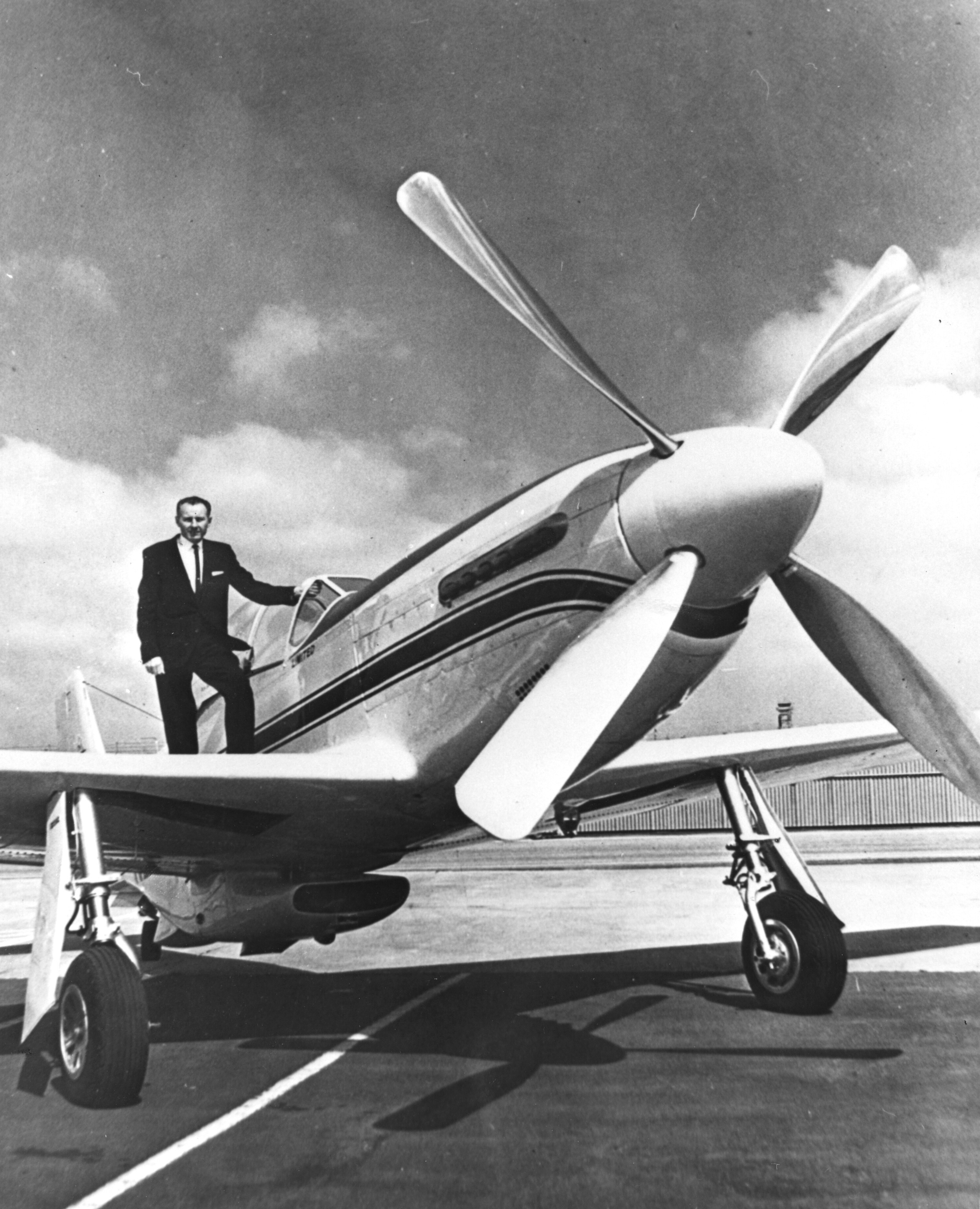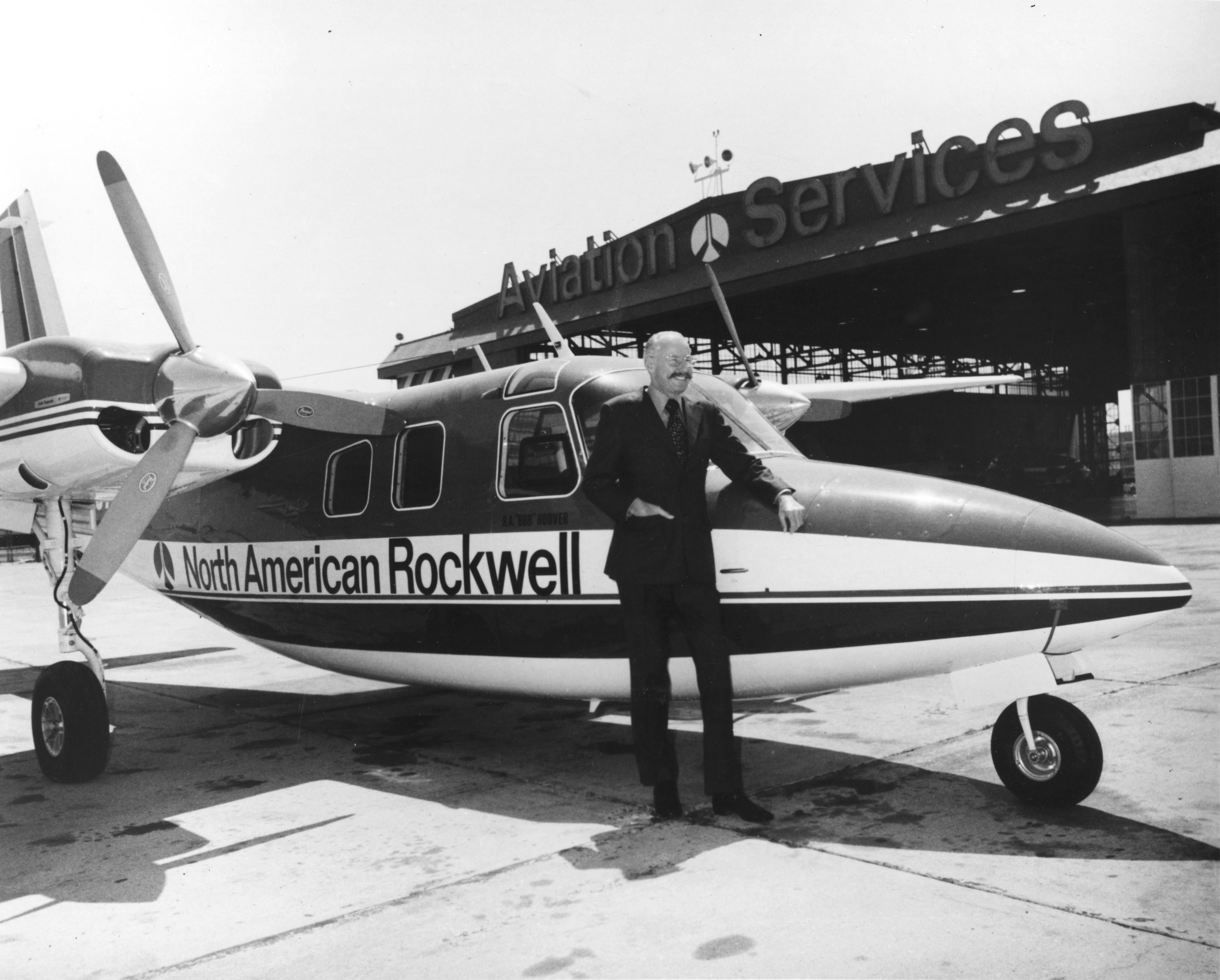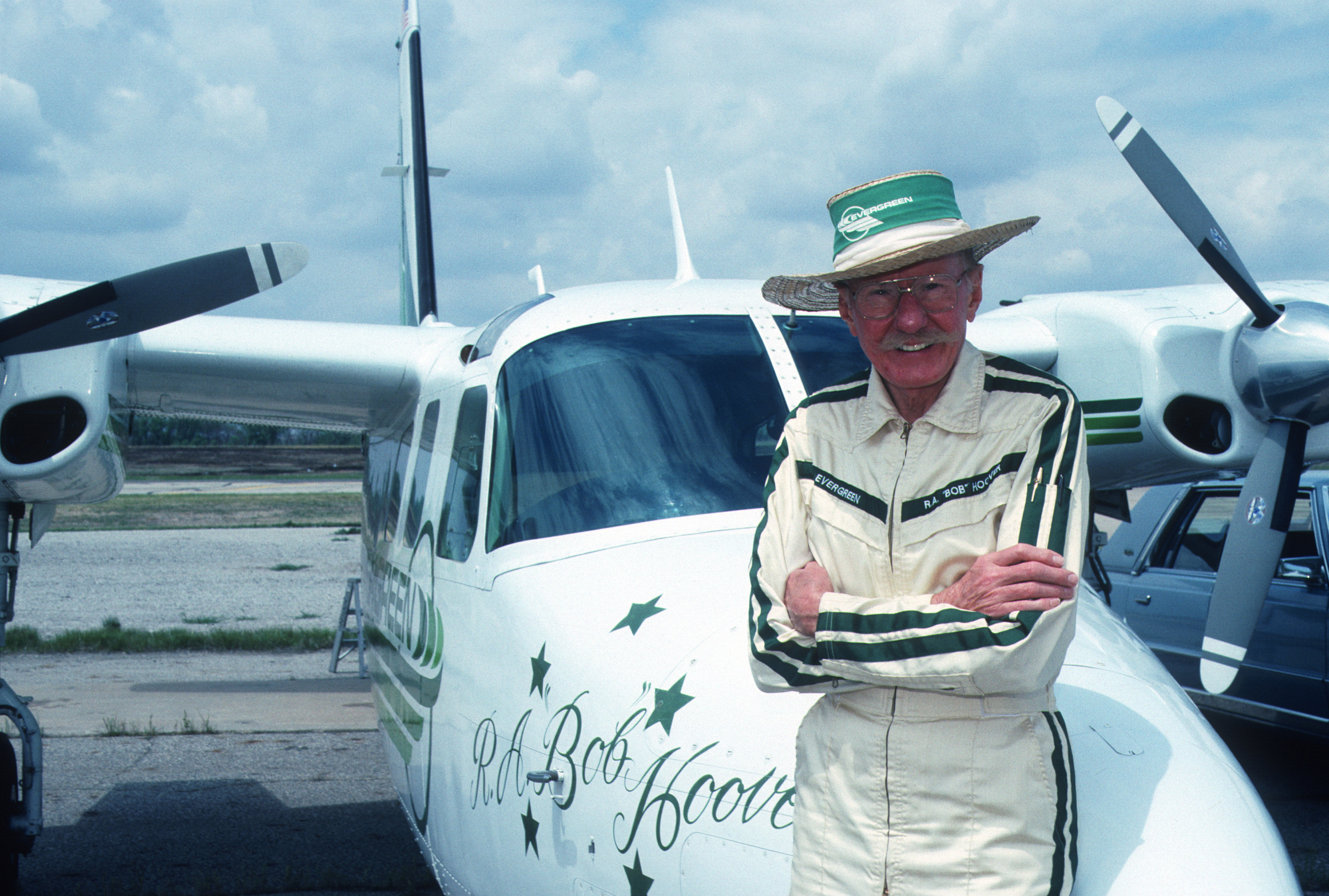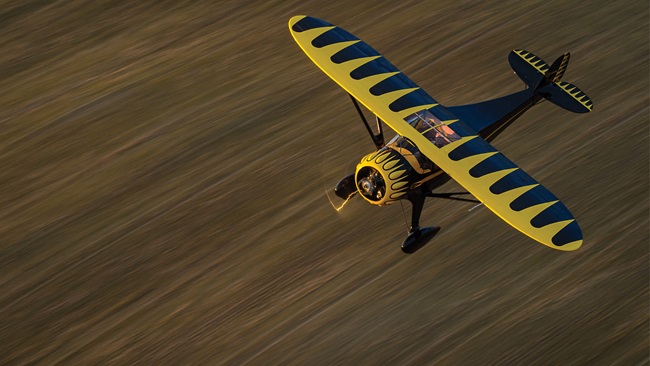Aviation Legend Bob Hoover dies at 94
Who knows how twenty-first century aviation might be different if Nashville’s 16-year-old Robert A. “Bob” Hoover had told his mother that day back 1938 that he was headed to Berry Field to begin flight training. She undoubtedly would have opposed such a whimsical use of the money he earned working at the local grocery store. But he didn’t ask and he soloed months later in a Taylor Cub, setting off a series of events that led to Hoover becoming among the most renowned and enduring test and airshow pilots in history.
The winner of hundreds of military and aviation awards, including the prestigious Wright Brothers Memorial Trophy in 2014, Hoover died Oct. 25 in Los Angeles at age 94. While frail in recent years, he lived at home and relatively pain free until the last few days, according to close friends.
It is similar to advice AOPA President Mark Baker heard the famed pilot extol years earlier when he first met him. “The first time I met Bob, I was seated next to him at an aviation event, my 8-year-old son by my side. Bob both spoke and listened to his aviation dreams. He offered encouragement and some great stories. And though my son is long since grown, neither he nor I have ever forgotten that an aviation legend gave a child who dreamed of flying his full attention and encouraged him to dream even bigger.”
It was advice that Hoover would follow himself, persevering to learn to fly as a youth, joining the Tennessee Air National Guard at 18 as a gunner, and teaching himself to fly aerobatics—an effort to help overcome persistent airsickness.
His efforts would pay off as he became a fighter pilot in World War II, flying most everything in the Army Air Corps’ fleet, but only after bluffing his way through the military medical certification process. Hoover’s eyes were not good enough to pass the eye exam. He told how the doctor, recognizing Hoover’s skill as a pilot and wanting him to succeed, indicated the eye chart on the wall and then told the young pilot he had to leave the room for another appointment. In 15 minutes he would be back to complete the eye exam. Of course, while alone in the room Hoover memorized the bottom line of the chart and easily passed the exam.
 During military flight school the instructor in a Stearman demonstrated a slow roll for Hoover and then asked the student to give it a try. “And I did him an eight-point hesitation roll,” Hoover told AOPA Pilot during an interview in 1989. “He looked at me and asked, ‘Would you do that again?’ So I did it the other direction.”
During military flight school the instructor in a Stearman demonstrated a slow roll for Hoover and then asked the student to give it a try. “And I did him an eight-point hesitation roll,” Hoover told AOPA Pilot during an interview in 1989. “He looked at me and asked, ‘Would you do that again?’ So I did it the other direction.”
Hoover’s natural piloting skills would help him survive many scrapes in airplanes. He was shot down in a malfunctioning Spitfire off the coast of France in 1944 and taken prisoner by the Germans. He escaped the prison after 16 months, stealing a German Fw 190 and flying it to the Netherlands to safety.
After the war, Hoover became a test pilot, flying the early jets to their limits and beyond. Jammed flight controls on an F-86 nearly cost him his life, but he managed to coax the airplane to the California desert where he set it down on the gear going more than 210 knots and “rolled 11 miles across that lake bed.”
Hoover became famed test pilot Chuck Yeager’s backup pilot on the Bell X-1 supersonic flight test project. Hoover flew chase in a Lockheed P-80 during Yeager’s first Mach 1 flight, but he never got a chance to fly the X-1. Instead, he was put out of commission for months after he ejected out of a burning F-84 during a test flight.
He left the military in 1948 and went to work for General Motors Allison Division, working on jet engines and propellers. Later, North American hired him. When it merged with Rockwell, Hoover began flying the P-51 Mustang in airshows. He also was introduced to the Aero Commander, a piston-powered twin-engine high-wing business aircraft that wasn’t selling well. Hoover checked it out and developed an amazing airshow act that had customers clamoring for the otherwise dowdy airplane. Over the years, his routine in the Shrike Commander became his signature act, doing loops and rolls on one, two, and no engines. He could do a one-G roll while pouring iced tea into a glass on the glareshield without spilling a drop. His breathtaking engine-out routine inspired a generation of pilots. Taking off under power, he would shut both engines down, do an entire routine, land, and roll to a stop in front of the grandstands, stepping out waving his signature Panama hat. The Shrike Commander is on display at the National Air and Space Museum’s Steven F. Udvar-Hazy Center outside Washington, D.C.
It was a dead stick act that would open a dark chapter in his airshow career. In 1992, two FAA inspectors claimed Hoover performed poorly during one show, despite video and eyewitness accounts to the contrary. Later, after Hoover had flown another 33 airshows, the inspectors reported their findings and the FAA asked for his medical certificate. He obliged and at his own expense went through a battery of medical exams. The FAA’s appointed doctor found nothing wrong and recommended he get his certificate back. The FAA refused and issued an emergency revocation, despite no evidence of any medical problem. The case dragged on for more than two-and-a-half years, during which Hoover got an Australian pilot certificate and continued to perform shows internationally.
He was represented before the FAA, the NTSB, and in the courts by friends F. Lee Bailey and AOPA General Counsel John Yodice. Ultimately, the FAA in 1995 returned his medical certificate without ever offering an apology or explanation.
 The FAA’s baseless actions against Hoover sent fear through the entire pilot population. The thinking was that if they can do it to a famous pilot they can act against any pilot. AOPA, other organizations, and legislators set out to rein in the agency with what became to be known as the “Hoover Bill.” Introduced by AOPA member Sen. James Inhofe (R-Okla.), the bill, ultimately signed into law, allowed pilots the chance to immediately appeal an FAA emergency certificate revocation to the NTSB chairman.
The FAA’s baseless actions against Hoover sent fear through the entire pilot population. The thinking was that if they can do it to a famous pilot they can act against any pilot. AOPA, other organizations, and legislators set out to rein in the agency with what became to be known as the “Hoover Bill.” Introduced by AOPA member Sen. James Inhofe (R-Okla.), the bill, ultimately signed into law, allowed pilots the chance to immediately appeal an FAA emergency certificate revocation to the NTSB chairman.
Phil Boyer was president of AOPA at the time and reflected on the impact after hearing about Hoover’s death: “There are a handful of issues during my tenure as AOPA's president that I would classify as iconic. The revocation of Bob Hoover's medical was felt by all of us who depend on that document in order to fly. There was no hesitation on the association's part to devote the financial, political, and legal support to the injustice the FAA imposed on this amazing aerobatic pilot.”
The level of trust between pilots and the FAA has never been the same. “The FAA has never recovered from the Hoover case,” said Yodice upon hearing of Hoover’s passing. “He was persecuted by the FAA—unjustifiably. And yet he never had a bad word about the FAA even though he was entitled to. He’s been a perfect gentleman all the years I’ve known him. The grace and gentleness we experienced with him, that’s what I will remember.”
Bill Fanning of Pilot Insurance Center was a 15-year-old cadet at the Marine Military Academy in Texas when he met Hoover at an airshow. That was 40 years ago. They became lifelong friends, often flying together. Remembering his times with the man who Jimmy Doolittle called the greatest stick-and-rudder pilot of all time, Fanning asks, “Do you know how humbling it is to be a 20-something flying a Bonanza with Bob Hoover in the right seat? I asked him if he wanted to fly, and he said, ‘No, you’re doing great.’ It’s like being told by the best quarterback in the NFL that you throw well. He gave me so many life lessons that I will have until I’m gone. Who’s going to fill his shoes in aviation?”
With Hoover’s frequent coaching of young airshow and race pilots, Fanning wondered how many lives Hoover has saved. After a misfueling accident in the Aero Commander, Hoover went on an education campaign that resulted in the Hoover Ring and the Hoover Nozzle. A lineman put jet fuel into the Aero Commander, which looks remarkably similar to the turboprop-powered Twin Commander. Hoover crashed shortly after takeoff when the piston engines failed. To prevent such accidents, the industry created an oblong ring to fit into fuel filler necks in turbine airplanes that will only accept an oblong nozzle attached to jet fuel trucks. The Hoover nozzle is now required on jet fuel trucks.
Although Hoover’s birthday is Jan. 24, 1922, Fanning and several other industry friends have for years organized the annual Bob Hoover Birthday Party every July at EAA AirVenture. Hoover would routinely sit for hours around a fire pit, telling stories of his life, in recent years, a microphone necessary as his voice weakened, his drooping shoulders draped with a blanket. Mesmerized pilots and families held steadfast by his tales.
Hoover won countless awards for his aviation prowess and military service. Among them were the Distinguished Flying Cross, Air Medal with Clusters, and Purple Heart. In addition to the Wright Trophy, he was named a Living Legend of Aviation and is in the National Aviation Hall of Fame. In 2016 a statue of the aviator was enshrined next to the Shrike Commander at the National Air and Space Museum. At the same time, a trophy was established in his honor—with Hoover himself the first winner. AOPA has taken up the mantle of managing the Hoover Trophy in perpetuity, which will be awarded annually to “a living aviator who exhibits the airmanship, leadership, and passion for aviation and life demonstrated by R. A. ‘Bob’ Hoover during his distinguished career as a pilot and aviation advocate while also serving as a source of inspiration and encouragement for current and prospective aviators.” The next award will be in early 2017.
Learning of Hoover’s death, AOPA’s Baker reflected on the award. “Bob Hoover was so much more than a great pilot. He was a great man and a model for what our community can and should be. We are honored to be able to perpetuate his legacy through the Bob Hoover Trophy.”
His life is the subject of several books and films. The most recent film was created by The Bob Hoover Project and is titled Flying the Feathered Edge.
Hoover’s wife Colleen died in March 2016. They were married 65 years. He is survived by his son Rob, daughter Anita, and millions of friends and admirers.




